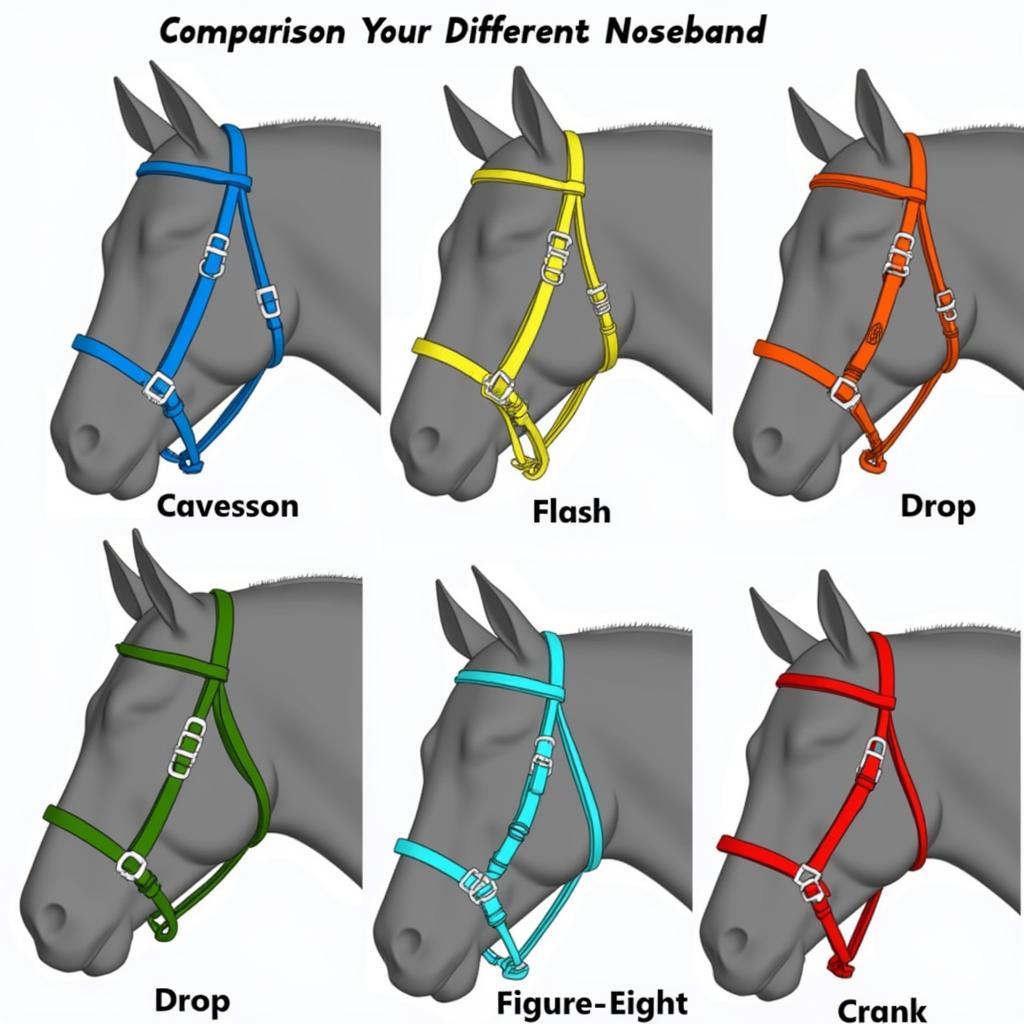Nosebands For Horses are a common piece of tack, but their purpose and proper fit are often misunderstood. Selecting the right noseband is crucial for your horse’s comfort and performance. This guide will delve into the various types of nosebands, their intended uses, and how to ensure a proper fit for your equine companion.
Understanding the Purpose of Nosebands
Nosebands primarily serve to keep a horse’s mouth closed and prevent them from evading the bit. They can also provide a point of attachment for other equipment like standing martingales. However, nosebands should never be used to forcefully close a horse’s mouth or restrict its breathing. A properly fitted noseband allows the horse to chew, swallow, and breathe comfortably. Different disciplines and riding styles may prefer certain types of nosebands, but the horse’s individual needs should always be the priority. Choosing the correct noseband can improve communication between horse and rider, ultimately leading to a more harmonious partnership.
Types of Nosebands for Horses
Several types of nosebands are available, each with its own specific function and characteristics. Let’s explore some of the most common options:
- Cavesson Noseband: This is the most basic and versatile type, often used for general riding and flatwork. It sits about two fingers’ width below the cheekbone and helps stabilize the bit.
- Flash Noseband: This noseband incorporates a flash strap that runs across the horse’s nose, preventing it from opening its mouth too wide. It’s commonly used for jumping and cross-country.
- Drop Noseband: This noseband sits lower on the horse’s face, across the nasal bone. It’s designed to discourage the horse from raising its head too high and resisting the bit.
- Figure-Eight Noseband: Shaped like a figure eight, this noseband crosses over the nose and encircles the bit. It offers more control than a cavesson but less than a crank.
- Crank Noseband (Lever Noseband): This noseband has a lever action that tightens when the reins are engaged. While effective in preventing mouth opening, it can be severe if misused and should be used with caution and expertise.
Ensuring a Proper Fit for Nosebands for Horses
A poorly fitted noseband can cause discomfort, restrict breathing, and even lead to behavioral problems. Here’s how to ensure a proper fit:
- Two-Finger Rule: You should be able to fit two fingers comfortably between the noseband and the horse’s nasal bone.
- Check for Chafing: Regularly inspect the area around the noseband for any signs of rubbing or hair loss.
- Adjust the Cheek Pieces: The cheek pieces should be adjusted so that the noseband sits correctly without interfering with the bit.
- Consider the Horse’s Anatomy: Some horses have more delicate facial structures than others, requiring a more carefully fitted noseband.
“A well-fitted noseband is essential for both the horse’s comfort and the rider’s control,” says Dr. Amelia Hartman, Equine Veterinarian and Riding Instructor. “It’s not about restriction but about creating a clear and consistent connection between horse and rider.”
Which Noseband is Right for My Horse?
Choosing the appropriate noseband depends on your horse’s individual needs and your riding discipline. A young horse learning the basics might benefit from a simple cavesson, while a horse with a tendency to evade the bit might require a flash or drop noseband. Always consult with a qualified trainer or riding instructor for personalized advice.
 Various Horse Nosebands: Cavesson, Flash, Drop, Figure-Eight, Crank
Various Horse Nosebands: Cavesson, Flash, Drop, Figure-Eight, Crank
Common Noseband Problems and Solutions
- Excessive Tightening: Over-tightening can restrict breathing and cause discomfort. Always adhere to the two-finger rule.
- Rubbing and Sores: Ensure the noseband is clean and properly padded. Check regularly for any signs of irritation.
- Evading the Bit: If the horse is still evading the bit despite the noseband, consult a trainer to address the underlying cause.
“Remember, the noseband is a tool, not a punishment,” advises John Davies, Master Saddler and Horseman with over 30 years of experience. “Its purpose is to aid communication, not to enforce control through force.”
 Addressing Noseband Rubbing on a Horse
Addressing Noseband Rubbing on a Horse
Conclusion
Choosing the right nosebands for horses is crucial for their comfort, performance, and overall well-being. By understanding the different types, ensuring a proper fit, and addressing any potential issues, you can contribute to a more positive and harmonious riding experience for both you and your equine partner. Remember, a properly fitted noseband is about enhancing communication, not restricting the horse.
FAQ
- How tight should a noseband be? You should be able to fit two fingers comfortably between the noseband and the horse’s nasal bone.
- Can I use any noseband for any discipline? While some nosebands are more commonly used in certain disciplines, the horse’s individual needs should dictate the choice.
- What if my horse rubs its nose with the noseband? Ensure the noseband is clean, properly padded, and not too tight.
- Is a crank noseband always a bad choice? While it can be severe if misused, a crank noseband can be appropriate in certain situations under expert guidance.
- How do I know which noseband is right for my horse? Consult with a qualified trainer or riding instructor for personalized advice.
- What are the signs of a poorly fitted noseband? Rubbing, sores, head tossing, and resistance to the bit can indicate a poorly fitted noseband.
- Can I adjust the noseband myself? Yes, but if you are unsure, seek advice from an experienced equestrian.
Need further assistance? Contact us at Phone Number: 0772127271, Email: [email protected] Or visit us at: QGM2+WX2, Vị Trung, Vị Thuỷ, Hậu Giang, Việt Nam. We have a 24/7 customer service team.